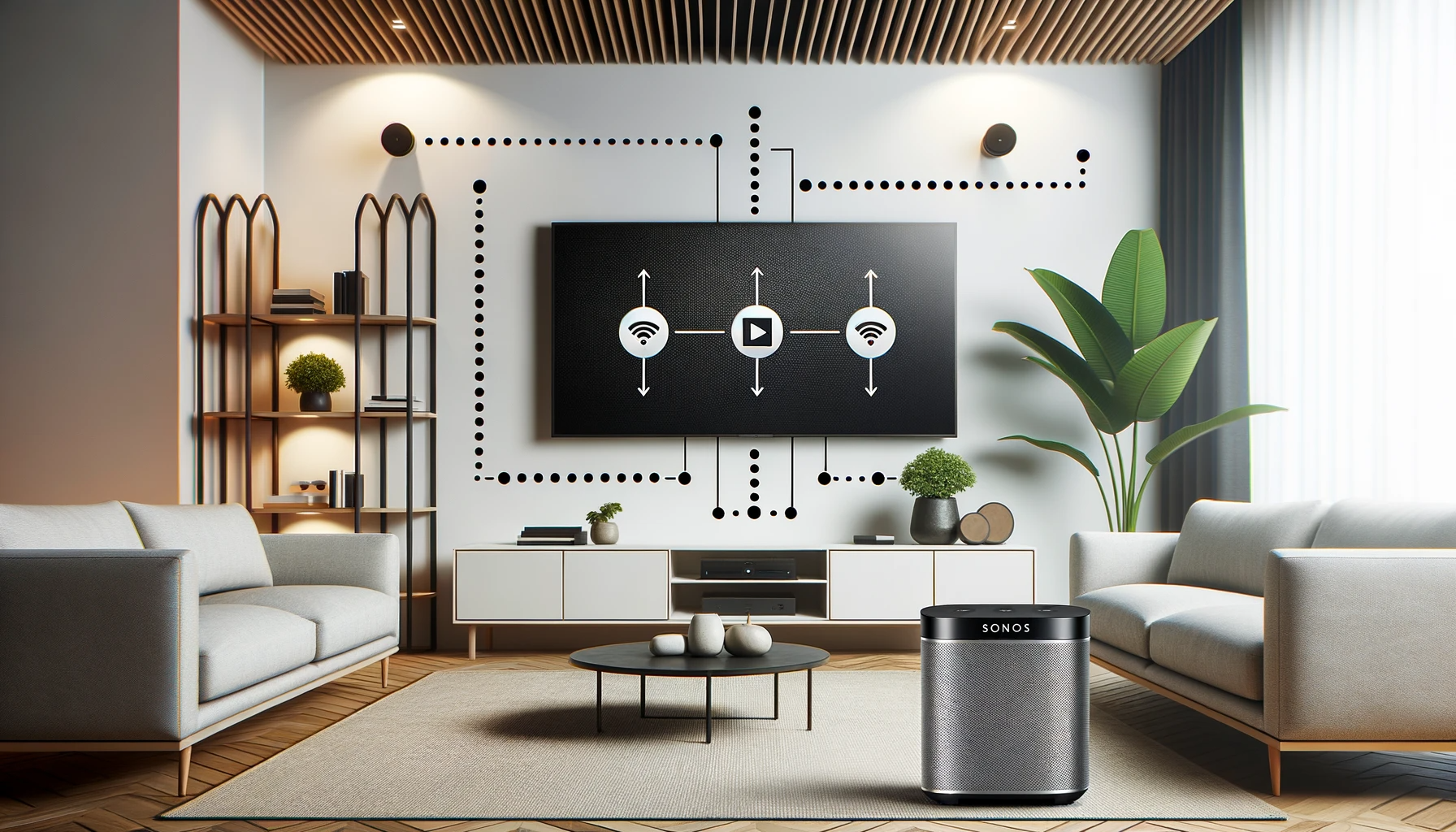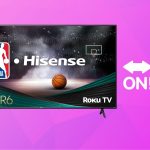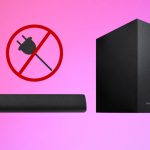Sonos speakers and soundbars are a great choice to enjoy immersive sound in your home theater. However, you may require help connecting your Sonos product, as each connects to the TV differently.
Let’s find out the different ways to connect Sonos to TV.
Connecting Sonos Soundbar to TV
Here’s how to connect your Sonos soundbar to your TV.
How to Connect Sonos Beam and Sonos ARC to TV?
This method is used to connect Sonos soundbars to your TV. You can connect your Sonos soundbar (Sonos Beam, Sonos Arc) to your TV through a wired connection, depending on the type of connection it supports. These soundbars only support an HDMI connection so you can connect it to the TV through the HDMI ARC/eARC connection.
HDMI ARC
If your TV has an HDMI ARC port, you can use this method to connect your Sonos Soundbar to your TV.
- Take an HDMI cable of the required length.
- Plug one end of the HDMI cable into the HDMI port on your Sonos Soundbar and the other end into the HDMI ARC port on the TV.
- Now, switch on your TV and Sonos Soundbar.
- Go to your TV settings and enable HDMI ARC from Audio Output settings.
- Test the connection by streaming some music from your TV.
Digital Optical
If your TV has a Digital Optical Connection (TOSLINK) instead of the HDMI ARC connection, you must use a Digital Optical cable to connect the Sonos to the TV. While some Sonos soundbars support a TOSLINK (Digital Optical) connection, newer versions might not have this port.
So, you might need an HDMI to Digital Optical Adapter for this; luckily, most Sonos Soundbars come with such adapters. All you need to do is connect the HDMI cable to the HDMI port of the adapter, and it will work as a digital optical connection.
Here are the steps to connect your Sonos Soundbar to TV Via Digital Optical.
- Take an HDMI cable of the required length.
- Take the optical adapter, remove the protective cap, and attach the optical adapter to the HDMI Cable.
- Plug the optical adapter side of the cable into the TOSLINK port of your TV and the HDMI side into the HDMI port of your Sonos ARC or Sonos Beam Soundbar.
- Turn on the TV and Soundbar.
- Enable the Optical output from the Audio output settings of your TV.
- Test the connection by streaming music from your TV to see if the connection was successful.
How to Connect Sonos Ray Soundbar to TV?
Sonos Ray Soundbar comes with a digital optical port for connectivity. So, you can use a simple Digital optical cable and connect one end of the cable to the soundbar and the other one to the TOSLINK port of the TV. However, if you are using a newer TV model, it’s unlikely to have a Digital Optical TOSLINK Port. In this case, you must use an HDMI cable with a digital optical adapter. Here are the steps to do so:
- Take an HDMI cable of the required length and an Optical Adapter.
- Connect one end of the HDMI cable with the Optical Adapter and plug it into the TOSLINK port on your Sonos Ray Soundbar.
- Connect the other end of the HDMI cable to your TV’s HDMI ARC/eARC port.
- Plug the power cord into the soundbar and turn it on.
- Enable the Optical Output from the Audio Output of your TV settings.
- Test the connection by playing music from the TV.
Connecting Sonos Speakers To TV
If you have Sonos Surround Speakers, Sonos Sub, and the Sonos soundbar, you can set up your Sonos home theater by connecting them to your TV.
Here’s what you need to do for this setup.
- Connect your Sonos Soundbar to the TV using HDMI ARC or Digital Optical.
- Put the Sonos Soundbar, speaker, and subwoofers in the desired position.
- Download the Sonos app on your phone and launch it.
- Follow the on-screen instructions to add Sonos speakers to your Sonos System.
- Next, go to Settings>System>Home Theater Settings in the app.
- Tap on Add Surround Sound Speaker and pair your Surround Sound speakers to the Soundbar.
- You can even add a subwoofer by navigating to Settings> System> Home Theater Settings> Add Subwoofer.
- Test the setup by streaming music from the TV.
Connecting Sonos Move, Roam, Roam SL Speakers to TV
Some Sonos Portable speakers like Sonos Move, Roam, and Roam SL can wirelessly connect to the TV via Bluetooth. Here’s how you can do it.
- Turn on your TV and Sonos Portable speaker.
- Enable Bluetooth on your Sonos Speaker by pressing and holding the Bluetooth button.
- Go to your TV settings and enable Bluetooth. Tap on “Pair New Device” or “Search for Available Devices.”
- Once the TV discovers your Sonos Speaker, select the name from the list to connect it with the TV.
- After connecting the Sonos speaker to the TV via Bluetooth, play some music on the TV to test the connection.
Connecting Play1, Play 3, Play 5, Era 100, and Era 300 Speakers to TV
Some traditional Sonos Speakers, like Play 1, Play 3, Play 5, Era 100, and Era 300, do not connect to the TV directly. To connect them to the TV, you first need to connect these speakers to the Sonos Soundbar and then indirectly connect them to the TV. These speakers do not have an input to receive the TV signals. I tried connecting these speakers to different soundbars and found that the Era 100 can connect to the Sonos Ray, Beam Gen 2, and Arc. Meanwhile, the Era 300 is compatible with both Beam Gen 2 and Arc.
Here’s how you can connect these speakers to the TV.
- Connect your Sonos soundbar to the TV using HDMI ARC or Digital Optical.
- Turn on your TV and Sonos Soundbar.
- Go to Settings on your TV and find Audio Output Settings. Adjust or change the audio output according to the connection.
- Download or install the Sonos app on your mobile phone if you don’t have it already.
- Launch the app and follow the on-screen instructions to set up your Sonos soundbar.
- After the app detects your Sonos soundbar, follow the on-screen instructions to add the soundbar to the Sonos System.
- Now, pair these Sonos Speakers with your Soundbar. Go to Settings>System>Home Theater Settings in the app.
- Tap on Add Surround Sound Speaker and pair your Surround Sound speakers to the Soundbar.
- Test the connection by playing some music from the TV.
Connecting Sonos To TV Via AirPlay
Some newer models of Sonos Speakers come with a feature called “Sonos AirPlay Integration.” If you’re using an APPLE TV, you can easily pair it with the Sonos speaker using the AirPlay integration feature. Here’s how you can do it.
- Check the Sonos speaker for Sono AirPlay 2 compatibility.
- Ensure the Sonos speaker and Apple TV are connected to the same Wi-Fi.
- Go to the Control Center on your Apple TV using the remote.
- From the Control Center, look for the AirPlay sign and select it.
- You’ll see a list of available AirPlay devices on your network. Look for your Sonos Speake from the list and select it for the connection.
- Play some music on your Apple TV to test the connection.
Frequently Asked Questions
Sonos speakers come with Bluetooth to connect the speakers to the TV wirelessly. However, you must use a Bluetooth Transmitter if your TV isn’t Wi-Fi enabled. Simply connect the Bluetooth transmitter to the TV> follow the instructions on the device> turn on the Bluetooth on your Sonos Speaker and Bluetooth Transmitter> tap for connectivity.
Suppose you have connected your Sonos to the TV and don’t hear any audio. In that case, it might be because of the incorrect audio output settings (for wired connections, i.e., HDMI ARC or Digital Optical), Muted audio, or low volume.
Unfortunately, you can’t connect them to your TV directly, as they have no wired connectivity ports. However, you can connect them to your mobile via the Sonos app.
Conclusion
Connecting your Sonos to your TV can greatly enhance your audio experience. By following the guidelines and steps provided above, the process can be made simple and effective. Once you have successfully connected your Sonos to your TV, you may also find it helpful to know how to reset your Sonos speakers in case you encounter any issues in the future. Additionally, if you’re an iPhone user, don’t miss our guide on how to connect Sonos to your iPhone. Enjoy your enhanced audio experience with Sonos!

I’m Shaun Conroy, an audiophile & founder of HiFi Audios. Holding a Bachelor’s in Sound Engineering, I bring deep expertise in audio devices and offer insights & recommendations to fellow enthusiasts.





